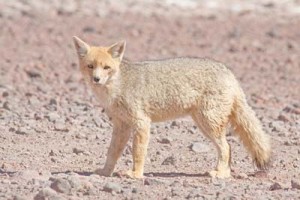Latest update November 28th, 2024 3:00 AM
Latest News
- $99B spent on Wales Gas plants to date, 58% of works completed – Prime Minister tells Parliament
- National Assembly clears $456M in Contingency Fund advances
- Hell and high water: Gaza waits for a ceasefire of its own
- Fire Service issues stern warning against maliciously set fires
- Miner stabbed to death during argument at ‘Honey Camp’
The Culpeo (Lycalopex culpaeus)
Mar 15, 2015 Features / Columnists, Interesting Creatures in Guyana
The Culpeo (Lycalopex culpaeus), sometimes known as the zorro culpeo or Andean
fox (wolf), is a South American species of wild dog. It is the second largest native canid on the continent, after the maned wolf. In its appearance it bears many similarities to the widely recognized red fox. It has grey and reddish fur, a white chin, reddish legs, and a stripe on its back that may be barely visible.
The culpeo’s diet consists largely of rodents, rabbits, birds and lizards, and to a lesser extent, plant material and carrion. The culpeo does attack sheep on occasion, and is therefore often hunted or poisoned. In some regions it has become rare, but overall the species is not threatened with extinction.
The culpeo was domesticated to form the Fuegian dog, but this became extinct sometime between 1880 and 1919.
This is a fairly large canid, intermediate in size between a red fox and a coyote. The mean weight of the much larger male is 11.4 kg (25 lb), while females average 8.4 kg (19 lb). Overall, a weight range of five to 13.5 kg (11 to 30 lb) has been reported. Total length can range from 95 to 132 cm (37 to 52 in), including a tail of 32 to 44 cm (13 to 17 in) in length. The pelage has a fairly attractive, grizzled appearance. The neck and shoulders are often tawny to rufous in colour with the upper back is dark. The bushy tail has a black tip.
Its distribution extends from Ecuador and Peru to the southern regions of Patagonia and Tierra del Fuego. Some populations live in southern regions of Colombia. It is most common on the western slopes of the Andes, where it inhabits open country and deciduous forests. Populations of the culpeo are also found in some of the westernmost of the Falkland Islands, where they were introduced by humans.
The culpeo fox is an opportunistic predator that will take any variety of prey. This fox mainly feeds on rodents, lagomorphs (especially the introduced European rabbit and European hare) and occasionally feed on domestic livestock, and young guanacos. Culpeos are considered beneficial because they are significant predators of the rabbits introduced in 1915; such introduced rabbit populations are believed to have allowed culpeos to spread from the Andean foothills across the Patagonian plain.
They sometimes take young lambs a week old and younger. In limited studies, the larger culpeo appears to dominate potential competitors, including South American grey foxes, Geoffroy’s cats, Pampas cats, grisons and various raptorial birds. Its range also overlaps that of the much larger puma, but the size difference ensures that the two species have limited competition.
The culpeo lives in a wide variety of habitats of western South America. They are found in broadleaf Nothofagus temperate rainforest, sclerophyllous matorral, deserts, and high plateaus, like the Altiplano, up to the tree line (4800 m).
The typical mating period is between August and October. After a gestation period of 55–60 days, the female gives birth to cubs. The females usually give birth to 2-5 pups among the rocks. (Source: Wikipedia – The Free Online Encyclopaedia)
Share this:
- Click to print (Opens in new window)
- Click to email a link to a friend (Opens in new window)
- Click to share on Facebook (Opens in new window)
- Click to share on WhatsApp (Opens in new window)
- Click to share on Twitter (Opens in new window)
- Click to share on Pinterest (Opens in new window)
- Click to share on Pocket (Opens in new window)
- Click to share on Tumblr (Opens in new window)
- Click to share on Reddit (Opens in new window)
- Click to share on LinkedIn (Opens in new window)
Related
Similar Articles

The Glenn Lall Show | November, 20th, 2024
Follow on Tik Tok @Glennlall
THE BLUNT OF THE DAY

Sports
Nov 28, 2024
Kaieteur Sports- Long time sponsor, Bakewell with over 20 years backing the Kashif and Shanghai Organisation, has readily come to the fore to support their new yearend ‘One Guyana’ branded Futsal...Features/Columnists
The illusion of compliance
…Peeping Tom Kaieteur News- A company can meet the letter of the law. It can tick every box, hit every target. Yet,... more
Rising Gun Crimes in the Caribbean: Urgent Action required by all
By Sir Ronald Sanders Kaieteur News – There is an alarming surge in gun-related violence, particularly among younger... more
Publisher’s Note
Freedom of speech is our core value at Kaieteur News. If the letter/e-mail you sent was not published, and you believe that its contents were not libellous, let us know, please contact us by phone or email.
Feel free to send us your comments and/or criticisms.
Contact: 624-6456; 225-8452; 225-8458; 225-8463; 225-8465; 225-8473 or 225-8491.
Or by Email: [email protected] / [email protected]
Weekend Cartoon















